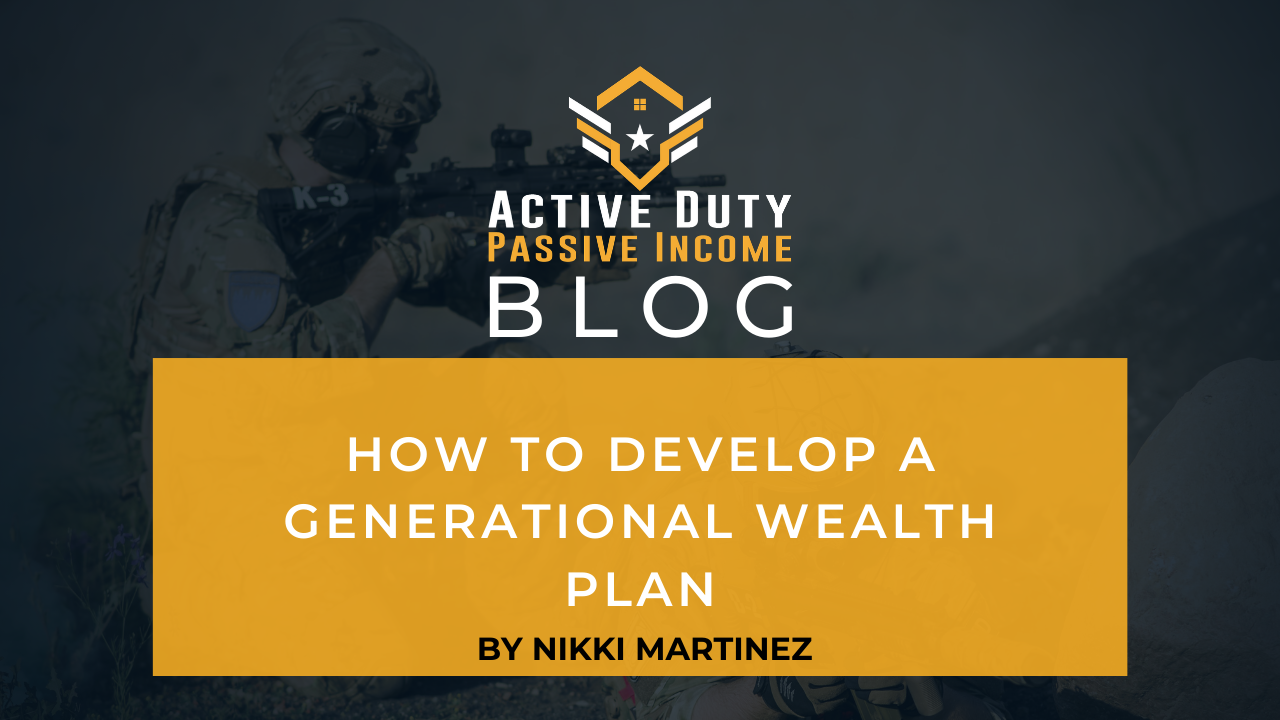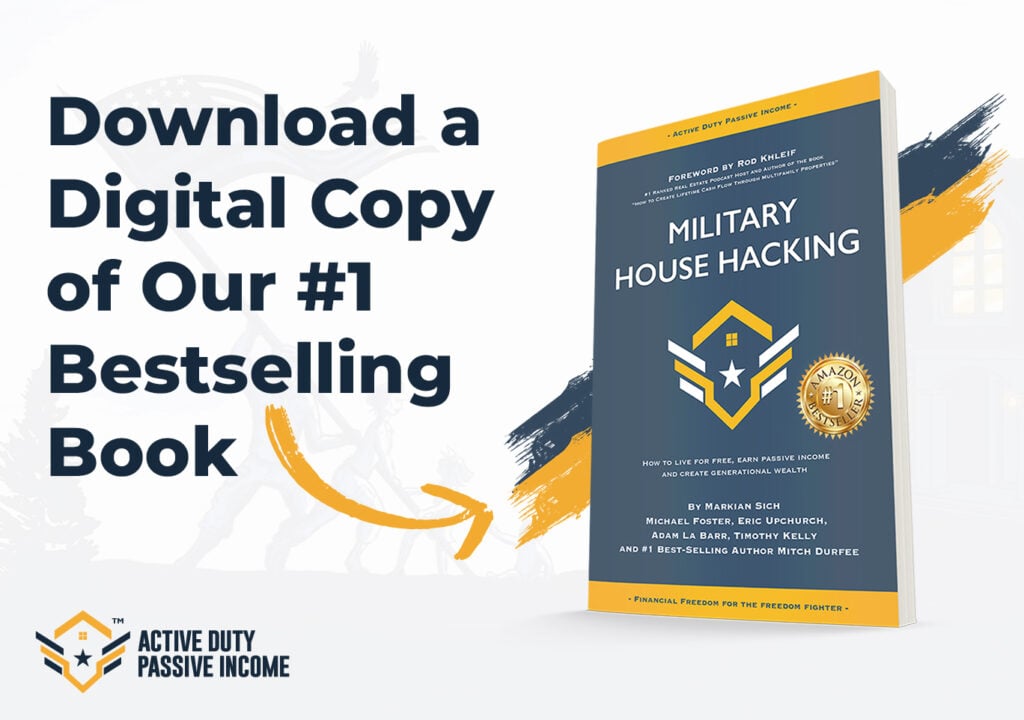What is a Generational Wealth Plan?
When you ask most people why they work so hard to increase their net worth and gain financial independence, they almost always answer something to the effect of- “I want the freedom to spend time with my family” or “I don’t want my kids to struggle as I did”. Family is a powerful motivator, yet many people do not have a comprehensive plan for ensuring that their wealth passes to their heirs or that their beneficiaries have the financial education to increase their wealth further after you die.
There is irony in the fact that to create generational wealth, you need to act and plan as if you already HAVE generational wealth. Rich people do not leave their family’s inheritance or financial education to chance, and neither should you. The great news is that, as a member of the military, you have access to fantastic resources that can help turbocharge your children’s future.
To create our plan, we started with a broad picture of what we wanted for our family’s future and then broke that down into actionable goals. We wanted to ensure that our child can leave the nest at age eighteen with enough resources to succeed in any job market. This means access to higher education, freedom from debt, good credit, and enough money to buy a starter home or invest in a business. We wanted to enable our child to succeed without impacting our retirement or quality of life. Like any effective plan, you must first establish your goals and work backward to meet them.
Goals:
1) A “free” advanced degree
2) A starting fund for entry into adult life
3) A foot in the door for life insurance without a health screening,
4) Stability in the event of our death,
5) Access to our assets after death, and
6) A solid financial education and good credit score.
We can invest up to $500/month for our child from birth to completion of the goals or age eighteen, whichever comes first. (Wait, you say! I don’t have $500 a month. NO PROBLEM AT ALL! Just adjust goal #2 and work with what you have. The key is to start early and be consistent. Even $100-$200 a month over 18 years will produce impressive results.)
1) Free education:
- My spouse transferred his GI Bill to our child the day he was entered into DEERS. (There have been some changes with the GI Bill transfer rules over the past few years, speak with the Ed Center to find out if you are eligible.)
- If you are not eligible or are using your education benefits yourself, look into state 529 plans.
- The goal is to leave school with minimal or no debt. Student loans are crushing weights on young adults.
Cost: Additional 4-year military commitment and/or 529 contributions.
2) Providing a starting fund for entry into adulthood:
As we all know, life is unpredictable. Many of us joined the military because of the difficult economy after 9/11 or because of the crash of 2008/2009. I expect enlistments are going to shoot up again this year. The post-COVID-19 economy is going to be another rough time for young adults. Having access to money early in adulthood allows for decisions to be made from a place of strength rather than fear or desperation.
- For our family, the target was $100k by age eighteen. (This was based on the $500 we could allocate per month. $500 x 18 years x 12 months/year = $108K before growth or interest.)
- With proper investing, we will reach that amount WELL before age eighteen, likely around late elementary school.
- Once we reach our goals, we intend to shift that $500/month to other expenses that a maturing child incurs, such as sports, clothing, transportation, etc. We are attempting to keep misc. child expenses in the $500 range throughout his life so that we can stay on track for personal retirement goals.
- Avoiding expenses creeping up over time is as necessary for raising children as it is in budgeting for anything else. Emphasize to growing children that if their costs exceed the budget, they need to scale back or find a way to make up the difference themselves.
Cost: Completely dependent upon your budget. If you can’t do much now, commit to increasing it a little each year until you reach your goal amount. Consistency and time are the keys to success here.
3) A foot in the door for life-insurance without a health screening:
- Let’s start with a disclaimer: a lot of people have VERY strong opinions about life insurance products that are often based on rumor rather than facts. Do not rely solely on the opinions of your friends and family; go speak with a licensed professional to get proper advice for your specific needs and goals.
- Our goal was to provide our child with guaranteed access to reasonably priced life-insurance for the rest of his life, no matter what future health conditions he may develop. We do not care about the loss of our child’s income or the cost of a funeral before age eighteen. So, for OUR specific circumstances, this means that we wanted whole-life insurance versus a term life insurance plan.
- This is just one piece of our family’s overall life insurance plan. I believe in the value of BOTH term and whole-life policies to meet different needs and budgets, and we own both types of insurance.
- The huge perks of choosing a whole-life insurance plan for a very young child is that you can lock in rates, at low costs, for the rest of their life, and that we were able to start this policy without a health screening. We set the insurance up so that as our child ages, he can choose to buy specific amounts of additional coverage and will never need to have a health screening. By the time he is eighteen, the cash value will have grown enough that he can borrow against it or can choose to pay the premiums with it for the rest of his life. Making it free to him or a private loan source, whichever option he values more.
- If your family has a history of health conditions or your child is already EFMP, this could be a significant gift for your child as they reach adulthood.
Quick Review:
Term-Life Insurance – Coverage only covers a specific term, such as 15 or 30 years. As long as you pay premiums during this time, the coverage continues. If you live to the end of the term, the coverage expires, and you get nothing out of it except the peace of mind that it gave you. This is very important for people who have income that their family is currently relying upon to live. Most service members have inexpensive SGLI. This may or may not be enough coverage for your family but is a massive perk of service. Generally, term coverage is cheaper, and folks can afford much higher coverage amounts.
Whole or Universal-Life Insurance – This is more complicated insurance that you will need to discuss with an agent. But the broad strokes include the following features. Premiums are due for life, and as long as premiums are paid, the insurance continues. Typically, there is a portion of the policy that accrues a cash value that an owner can borrow against or use to pay future premiums when the cash amount has reached a high enough level. Some plans allow for a reduction of death benefits if a portion of the value is used during life to cover terminal illness expenses. Many times, there are tax-protection or estate-planning reasons to try and pass income to your heirs through this insurance. Generally, this type of insurance is much more expensive, and premiums must be maintained until death. The older a person is or the poorer their health, the more unaffordable this option becomes.
Cost: These vary wildly! For us, it is about $27 a month. This premium is deducted from the $500 that we allocated per month to our child.
Check out ADPI Insurance for information on how to acquire Whole Life Insurance: https://www.adpiinsurance.com
4) Stability in the event of your death:
This is a combination of ensuring that your family is taken care of financially (see life insurance discussion) and ensuring that the right people can quickly move in to take custody of children and assets when you die. The specific plans and documents needed will be discussed in step five, but the main points are:
- Create your plan. Make it actionable and as detailed as it needs to be.
- Disseminate the plan’s documents to EVERYONE who needs a copy.
- Make sure that everyone involved in your plan knows their role and is prepared to assume that role. (Check up on this as time goes by, don’t “set it and forget it.” People’s circumstances change.)
- Have difficult conversations about death with your spouse, your family, and your children. Confusion and uncertainty after your death make the loss hurt so much worse and can lead to terrible legal fights over custody or assets.
- Keep your children and your assets out of probate court as much as possible!
- If there is a family member that you do NOT want to access your money or raising your child, include that the documents. Include people you know well and trust with your child’s lives; you are not limited to only blood relations.
- REVIEW AND UPDATE YOUR PLAN REGULARLY! This means at least a yearly review, but absolutely an update after every major event: birth, death, divorce, change of roles in your support team, etc.
5) Access to your assets after death:
- You want to ensure that your loved ones have immediate access to your assets and children with as few legal costs or tax losses as possible after your death. You also want to ensure that your Beneficiaries or their Guardians and Trustees can access accounts and assets immediately to keep your businesses working without interruption.
- You will want to work with correct attorneys, CPAs, and other advisors to set these documents up correctly. Ensure your plan is all thorough and flexible. Update it every few years.
Documents you will want to have (at a minimum):
Will –
- This is the document that most people have if they have anything. It is a good item to have, but in many states, a Will still needs to go through probate court after your death, can be challenged, and should be considered a portion of your estate plan, not the entirety of the plan. But if you do nothing else, at least do this!
Trusts –
- A Trust is an entity, not just a document. It can own property, own businesses, be a life insurance beneficiary, as well as many other functions. It can continue to exist after you die. It tends to be more involved than a Will and can compel folks to follow your wishes very specifically after your death without needing to go through the court system. You can be very deliberate in dictating the care of children and assets in this document. You can put assets in a trust during your lifetime that can remain in your trust after your death. This creates certain legal protections both during your life and for your beneficiaries after your death.
- Work with a CPA and attorney during the set up understand how best to limit tax liabilities for your beneficiaries.
- You can include additional letters of intent and lists of assets with your Trust and Will. These are used to keep documents current in between updates every 2-5 years. The goal is to make it as easy as possible for your executor to know where to look for assets and what to do with everything.
- Once a Trust is created there will be an investment of time required to ensure that everything is moved into that Trust correctly (bank accounts, vehicles, businesses, property, etc.) Do not forget this critical step!
- Don’t forget to include your Trust in the future acquisition of assets.
Visit Anderson Business Advisors for any of your business entity needs.
Healthcare Directive –
- This feels morbid to discuss, but people do not always die quickly or without complicated or expensive circumstances. Ensure that your wishes are known and that the person (and back-up person) who is authorized to make decisions on your behalf are clearly identified and empowered.
Cost: about $2-3k for document creation. (Expensive, but so, so very worth it.)
6) Financial education and a good credit score:
Raising financially literate children is the key to making all of this work. You don’t want them to fritter away all of your hard work and good intentions from lack of knowledge, training, or misplaced priorities. You also don’t want to create a spoiled human who does not appreciate the value of what you are providing. Raising a caring and compassionate person is tough, raising one who is not spoiled or entitled is even harder. I do not have all of the answers for this, and I can only give you the outline of our plan and hope that you find something that adds value to your instruction.
We have been keeping a journal of actions that we have taken for our child’s investment plan. We update it monthly with what we invested in, the reasons for our decisions, how the investments fit into the overall family investment plan, and significant events happening in the world driving our choices. This journal is both a learning tool and a keepsake for our child.
Age-appropriate involvement plan activities can include:
- 1-5 years:
- Learn about money. What it is and how you buy things. (Ex. Helping to count money at a store, “paying” for little treats at home to practice counting and using it.)
- 5-10 years:
- Learn about budgeting and purchasing. (Ex. Helping with grocery shopping: budgeting, planning meals, using a list to collect items, “paying” at check out.)
- 10-15 years:
- Learn about income creation, investing, and budgeting.
- Start a Roth IRA for the child, max it out yearly. They can start “earning” money working for you at this age.
- Begin to “charge” for necessary things like car purchase, car insurance, gas, sporting equipment and fees, clothing, etc. These items come from invested money, income earned, or $500 a month.
- Bring them into the decision-making process in investing whatever remains of the $500 monthly and maintenance of the currently invested assets.
- Instead of an allowance, consider having them negotiate money for their efforts/products, make them find a way to generate income inside or outside of the home.
- 15-18 years:
- Provide oversight of investment decisions, but let the child run the show within reason.
- This is the practice phase to get them used to manage large quantities of money.
- Begin establishing the child’s credit by making them authorized users or co-signers on restrictive credit accounts (such as pre-paid cards) or utilities such as cell phones.
- Begin monitoring your child’s credit, just as you observe yours.
- Mentor real estate deals if that is part of your plan or your child’s interest.
- Assist in building business plans with your child to crystalize their goals.
- All income needs of the child should come from the $500 a month, their investments, or money that the child is bringing in through a job or entrepreneurial activities.
- Work on a plan to transfer money into the child’s control as soon as possible after they reach age eighteen without incurring tax liabilities.
- Educate them on debt and how to use it without abusing it.
- 18+ years:
- Finish transferring remaining portions of the $100k in either annual gifts, RE investments, business investments, etc. (Work with a CPA to ensure that you are doing this correctly.)
- Consider helping them create estate planning documents for themselves and using Trusts correctly in their future dealings.
- Review life insurance options with their current plan.
- Begin long-term care planning with your child for your elderly years and update plans accordingly. (Shift the focus of establishing who takes care of whom in this relationship to lessen your future impact on your children both financially and emotionally.)








